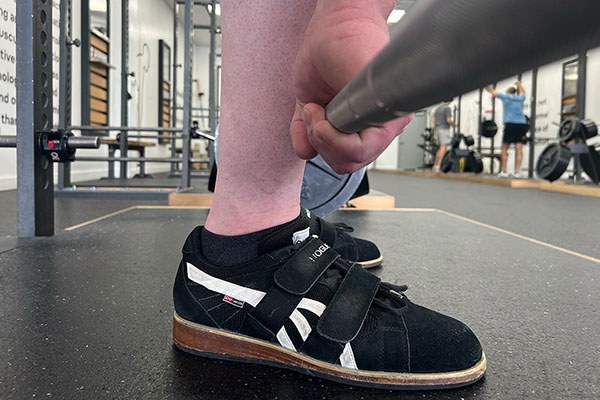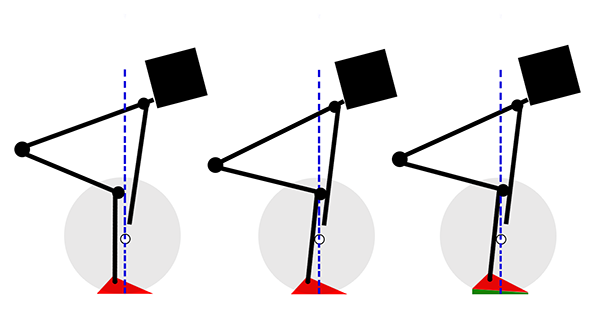
Don’t Blame Your Deadlift on Your Shoes
by Joe Jaloszynski, SSC and Mark Rippetoe
| May 29, 2024
The deadlift is difficult for everybody, and especially novices.
There is a lot to think about, and shoes are something people seem to
dwell on.
Let’s get this out of the way right now: if you
search the internet hellscape of social media, you will see most
elite powerlifters deadlifting in flat shoes. It is very hard to
argue with that data set, if you don’t understand data. Elite
powerlifters deadlift in shoes without any heel lift, but think
harder about the reason they are elite powerlifters – it has
absolutely nothing to do with their choice of footwear in the
deadlift.
Weightlifting shoes
protect the feet, reinforce the arches while they are loaded, and
provide lateral stability during the movement. But why have heels on
weightlifting shoes? Because they make it easier to use your quads to
extend the knees by putting the knees in a better position to extend
without creating too much knee angle. Extending the knee angle is what the quads do, and the more angle they
have to extend, the more force they can contribute to the lift –
within reason. The quads are big strong muscles, and it’s good to use
them off the floor in a deadlift. The quads are in a stronger
position to extend the knees the more extended they already are, and
that’s why everybody likes to half-squat.

A heeled shoe (right) increases the ability to use knee extension off the floor without pushing the bar forward of an efficient midfoot position. Note the shift of the tibia relative to the bar and subtle change in angle at the ankle.
But completely vertical shins/fully extended knees leave out the potential power of the quads, since some of the angle is already extended. This is a different exercise, a Stiff-Legged Deadlift, which you can’t do with as much weight as you deadlift. So knees need to be flexed a little to involve the quads off the floor – a little in front of the bar, but not so much that they push the shins and the bar forward of the mid-foot. If you’re standing on the ground, the ankles have to allow the knees to slide forward, and heels on the shoes make it easier to assume this position. Flats or bare feet drop the heels and close the ankle angle, adding calf muscle tension to this position. Heels raise the back of the foot, open the ankle angle (plantar flexion) a little, and make it easier to place the knees just forward of the bar. It’s a subtle but palpable difference.
What is the primary objection to a heeled shoe? Can it possibly be
the idea that they add a little distance to the pull? Even if they
make the first part of the pull stronger ? Note the fact that the bar
is over the middle of the foot, and that the middle of the shoe is
about half the height of the heel. This means that a shoe with a
3/4-inch heel increases the bar travel by maybe 3/8 of an inch. And
this is your objection to pulling 405 in heels? Seriously?
The
elevated heel of a weightlifting shoe tends to get blamed for a lot
of issues in the deadlift that are not the fault of the shoes. It’s
very easy to tell the quality of a coach if the first thing he says
after seeing a sloppy deadlift pulled with the bar 3 inches forward
of mid-foot, shoulders behind the bar, a flexed lumbar spine, while
looking up at the ceiling is, “Take your shoes off.” That’s
lazy coaching, and you as a paying client deserve better.
The
deadlift setup is quite simple. The blue book breaks it into five
steps. First, stand with the bar over the middle of the foot, one
inch from the shins; heel height never gets blamed here. The bar
being forward of mid-foot, more than 1 inch from the shins, cannot be
blamed on footwear.
Second, bend over and
take a grip on the bar that is just wider than your legs (shoes don’t
affect this). Don’t support yourself on the bar during this step,
because this will move the bar. We obviously know a little bit of an
elevated heel does not put a person forward when they bend over.
Women have been wearing heels much taller than 3/4″ for a long
time, and if those tall heels caused a person to fall forward, we
would know. Staying balanced when bending over to grab the bar is
quite easy: as you bend forward to grab the bar, move your hips back.
This will keep you balanced over the middle of the foot, regardless
of heel height.
Third, drop knees
forward until your shins touch the bar without moving the bar.
The common error is lifters rocking forward too far to bring their
shins to the bar, rolling the bar forward of mid-foot. This error
pitches the lifter forward of the balance point over the mid-foot,
and the heels get the blame. Simply taking the shoes off does not
change the issue. Perform Step 3 by breaking at the knees, which then
go forward and out, while the hips go back.
Balance is maintained by the heels which allow the forward shin
travel without putting the weight on the toes.
Fourth, take a big
breath, then set your back into normal anatomical extension and
squeeze your abs to reinforce this arched position. Step 4 is the
bogeyman with the shoes. In the correct position, the middle of your
foot, the bar, and your body’s center of mass (COM) are in a vertical
line. Often the lifter moves his COM forward of mid-foot at some
point in step 3. This makes step 4 extremely difficult. That is why
the book mentions the unofficial “Step 4.5”: a gentle rock
backward to put your COM back over mid-foot. This is a repair
mechanism that will not be necessary if Step 4 is done correctly –
if you don’t put your COM forward of mid-foot, you don’t have to fix
it with that simple adjustment. Your knees (not your COM) must be
slightly forward of your mid-foot in order to start the bar upward
with a knee extension, and heeled shoes actually help with finding
this important position. The best way to not have to do 4.5 is to do
3 and 4 correctly.
Then five, push the
middle of your feet down into the floor and drag the bar up your legs
until you are standing straight up, chest up, shoulders back. Most
problems in the deadlift setup are derived from your reluctance to
use your hips correctly, which adversely affects the rest of the
pull. Once the knee extension gets the bar off the floor, the hips
are the main driver of the deadlift, and they must be behind the bar
in the right place to stay in balance. You cannot lock out a heavy
weight if either you or the bar are forward of balance over the
mid-foot.
As coaches, we have
seen thousands of reps and taught countless people to perform the
lift. We know the problems that are going to happen when you
deadlift. We can predict the issues and we are ready for them –
that’s why the coach is there. And none of the issues we see are
because of the heels on the shoes. Don’t blame the shoes for
something you’re doing incorrectly.
This is very
important: we see people screw up Step 1, 2, 3, and 4 in flats
too. None of the set-up issues are caused by wearing lifting
shoes with an elevated heel.
As coaches, we know this because we have
seen those same setup errors occur with lifters wearing heeled shoes,
flats, and barefoot. Set up errors happen regardless of footwear. To
be clear: an elevated heel does not cause the lifter to set up out of
balance. The lifter causes the lifter to set up out of
balance. Stop blaming your shoes.
If your deadlift is
weaker than it should be, I promise you it is not because you are
deadlifting in heeled shoes. When you get your deadlift up to 750,
you can decide for yourself about your shoes. Novices do not have
weak points, they’re just weak, and that is an easy problem
to solve. We have a plan for that. Part of that plan is not to take
your shoes off. The difference between a 225lb deadlift and a 405lb
deadlift is never the footwear.
Discuss in Forums
Credit : Source Post






